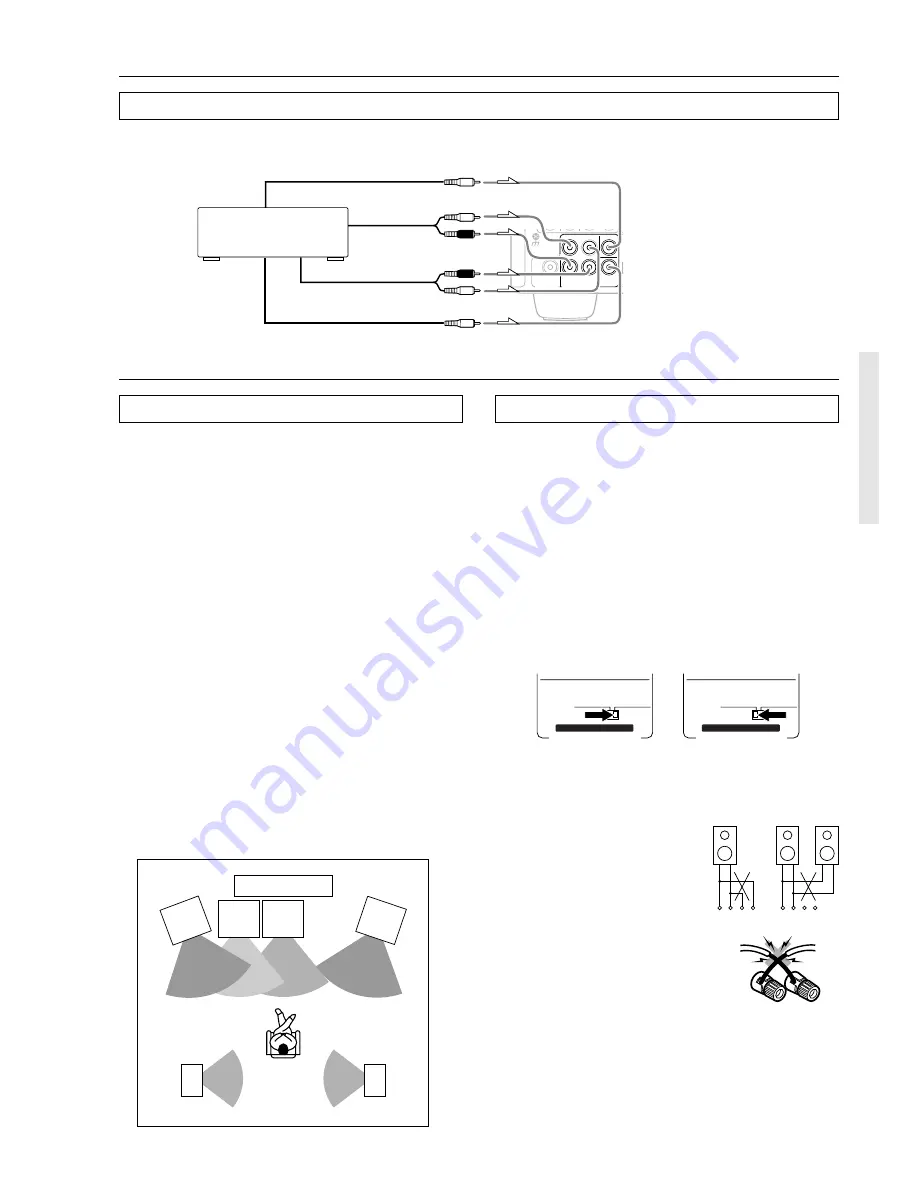
17
Connecting speakers
Connections
Connect to devices with multichannel output
By connecting a DVD player, MPEG decoder, or other component that has a multi channel port, you can playback the audio with 5.1 channel
output. So, be sure to prepare a cable that can properly connect the TX-DS696 to the peripheral device.
GND
CENTER
SUB
WOOFER
FRONT
SURR
SUBWOOFER
PRE OUT
MULTI
CHANNEL INPUT
L
R
DVD Player/MPEG decoder
Center output
Front output
Surround output
Subwoofer output
L (White)
R (Red)
R (Red)
L (White)
Positioning speakers
Speaker placement plays an important role in the reproduction of
Surround sound. The placement of the speakers varies depending on
the size of the room and the wall coverings used in the room. The
illustration shows an example of a layout for standard speaker
placement. Refer to this example when you position the speakers in
order to experience the best of Surround sound.
Standard speaker placement
For ideal Surround effects, all speakers should be installed. If a
center speaker or subwoofer is not connected, the sound from the
unused channel is properly distributed to the connected speakers in
order to produce the best Surround sound possible.
Front:
The left, right, and center speakers should face the seated
listener and be placed at ear level. The center speaker produces a
richer sound image by enhancing the perception of the sound’s
source and movement.
Surround:
Place the left and right Surround speakers 3 feet (1
meter) above the listener’s ear level and facing toward the sides of
the room, making sure that the listener is within the speakers’ dis-
persion angle. These speakers produce the feel of a moving sound
while creating the sensation of being in the middle of the action.
Subwoofer:
Install a subwoofer with a built-in power amplifier for
powerful bass sounds. The placement of the subwoofer does not
affect the final quality of the sound image too much, so you can
install it with the room layout in mind.
Refer to the speaker’s instruction manual for more details.
• Be sure to connect the positive and negative cables for the
speakers properly. If they are mixed up, the left and right signals
will be reversed and the audio will sound unnatural.
• Do not connect more than one speaker cable to one speaker
terminal. Doing so may damage the TX-DS696.
Connecting speakers
Make the connections while referring to the explanations on the next
page.
1. Check the impedance of the speakers you are
connecting.
The TX-DS696 requires speakers with an impedance of 4 or
greater. Connecting speakers with an impedance of less than 4
may damage the TX-DS696.
2. Set the IMPEDANCE SELECTOR switch according to
the impedance of the speakers being connected.
If all speakers have an impedance of 6 or greater, slide the
IMPEDANCE SELECTOR switch to the left (6 OHMS MIN./
SPEAKER). If one or more speakers have an impedance of less
than 6 , slide the IMPEDANCE SELECTOR switch to the
right (4 OHMS MIN./SPEAKER).
• When you are using only one speaker
or when you wish to listen to
monaural (mono) sound, a single
speaker should never be connected in
parallel to both the right and left-
channel terminals simultaneously.
• To prevent damage to circuitry,
never short-circuit the positive (+)
and negative (–) speaker wire.
Notes:
• The power to the TX-DS696 must not be turned on when
changing the IMPEDANCE SELECTOR setting.
+ – – +
+ – – +
R
L
R
L
TV or Screen
Center
speaker
Surround
right
speaker
Surround
left
speaker
Listener
Sub-
woofer
Front
right
speaker
NO!
6 OHMS
MIN.
/ SPEAKER
4 OHMS
MIN.
/ SPEAKER
IMPEDANCE SELECTOR
SET BEFORE POWER ON
6 OHMS
MIN.
/ SPEAKER
4 OHMS
MIN.
/ SPEAKER
IMPEDANCE SELECTOR
SET BEFORE POWER ON
4 or above/speaker
6 or above/speaker
NO!
Front
left
speaker
















































